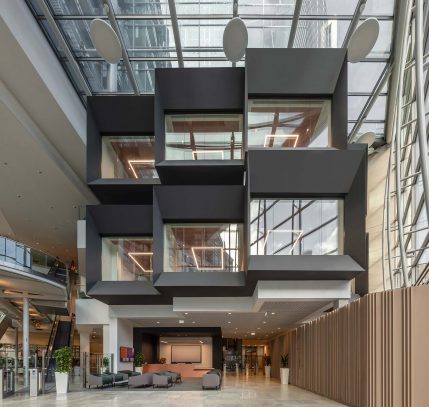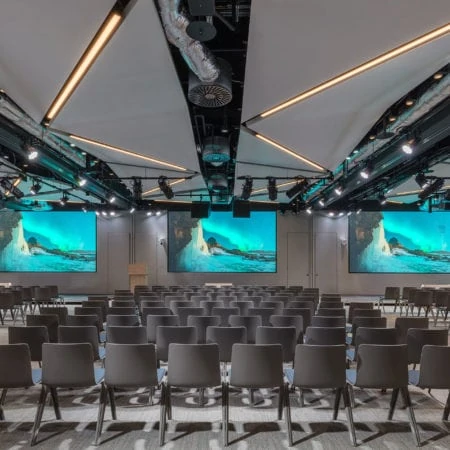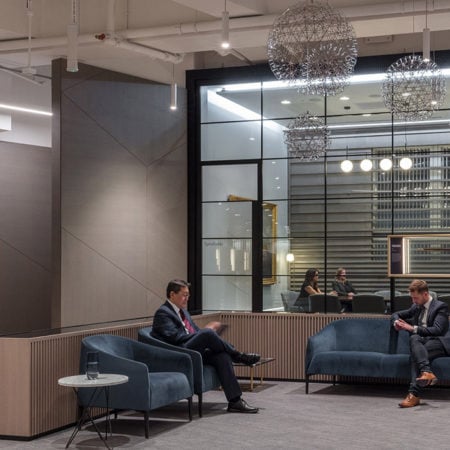Businesses are re-evaluating their offices and how they use their spaces for hybrid working. This presents an opportunity for creative reuse – transforming these existing spaces to not only deliver new ways of working, but to make them work harder for the building’s owners and tenants, and to be more sustainable. This extends from the building as a whole, right down to its materials, furniture and fittings.
LOM has recently completed our latest project for a major financial institution at its London headquarters. Our objectives were to make the most of the building’s usable space, enhance the workplace experience for staff, and extend the building’s lifespan to create a more sustainable headquarters fit for the future.
The 1990s building had a lot of underutilised space ripe for creative reuse. We transformed the building’s atrium with striking suspended pods to increase the number of meeting rooms. Redundant ground floor spaces were converted into a conference centre suitable for both internal and external events, alongside an executive meeting centre. While a flagship coworking space at the heart of the building now provides a vibrant work environment that supports staff wellbeing and collaboration.
The latest phase of the project was to refit 10 office floors to provide more flexible, collaborative workspace ideal for hybrid working. Achieving our client’s sustainability objectives meant thinking creatively about what this refit was leaving behind: hundreds of redundant desks, chairs and other furnishings.
LOM associate Chiara Cantilena said: “We took the opportunity to do something special and bespoke – upcycling these items and making them work in the new creative spaces. This isn’t just being thrifty, it’s also a chance to design eye-catching items that add to their space and deliver new functionality and ways of working.”
“Desktops were transformed into focus booths and colourful whiteboards, complete with handles where cut-outs once existed for PC wires. Others became moveable collaboration tables. The challenge is making these pieces look not reused, but tailor-made. We resprayed tired-looking desk bases in fun colours, remodelling them to include flexible storage and high level ‘tool rails,’ and replaced some of the tops with interesting finishes.”
Reuse is a learning curve for all and the more we do it, the better we will become at identifying opportunities to extend the lifespan of buildings and the materials we use. Investing in quality, durable items ultimately pays off in the long term as it is easier to reuse these items in the future.
It’s exciting when something destined for landfill is saved and repurposed. At LOM, we advocate a non-disposable culture that starts with the way we design buildings and spaces and continues with our everyday practices.
The result has been a rejuvenated workplace with increased usable space, more collaborative potential, and minimal waste. This mentality is what we need as all our workspaces undergo post-pandemic change. Change doesn’t have to mean waste. With creative reuse, businesses can have a fresh, bespoke and sustainable space fit for the future.

This article is by Simon Bird
Simon is a director of the practice, taking a leading role on strategic, interior and architectural projects.

This article is by Chiara Cantilena
Chiara is an associate at LOM with a special interest in materials and their innovative application in both architecture and interiors. She pays particular attention to user experience, collaborative work and interaction spaces and how they contribute to communicating corporate identity and values.









